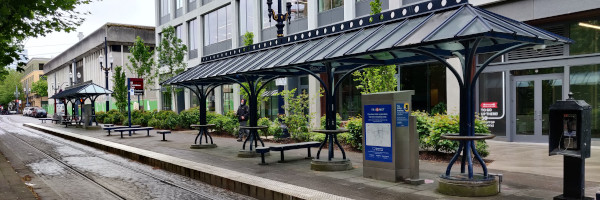Mobility Hubs: Difference between revisions
No edit summary |
No edit summary |
||
| Line 4: | Line 4: | ||
|authors=Wilfred Pinfold, Skip Newberry, Jeff Allen, Ken Montler, Timothy Smith, Joe Cortright, Greta Knappenberger, Jill Sorensen, John Feo, Corey Marshall, Jose Gonzalez, Geoffrey Urbach | |authors=Wilfred Pinfold, Skip Newberry, Jeff Allen, Ken Montler, Timothy Smith, Joe Cortright, Greta Knappenberger, Jill Sorensen, John Feo, Corey Marshall, Jose Gonzalez, Geoffrey Urbach | ||
|blueprint=Transportation | |blueprint=Transportation | ||
|sectors=Transportation | |||
|summary=A mobility hub is a transportation facility that provides multiple modes of transportation and serves as a central point for people to connect to different types of transportation services. Mobility hubs can be located in urban, suburban, or rural areas and can include a range of transportation options, such as buses, trains, bicycles, electric scooters, and carsharing services. | |||
|chapter=5004 | |chapter=5004 | ||
|email=wilfred.pinfold@opencommons.org | |email=wilfred.pinfold@opencommons.org | ||
|document=TransportationBlueprintFeb18.pdf | |document=TransportationBlueprintFeb18.pdf | ||
Latest revision as of 23:41, January 19, 2023
| Transportation | ||||||||||||||||||||||||||||||||||||
|---|---|---|---|---|---|---|---|---|---|---|---|---|---|---|---|---|---|---|---|---|---|---|---|---|---|---|---|---|---|---|---|---|---|---|---|---|

| ||||||||||||||||||||||||||||||||||||
| Sectors | Transportation | |||||||||||||||||||||||||||||||||||
| Contact | Wilfred Pinfold | |||||||||||||||||||||||||||||||||||
| Topics |
| |||||||||||||||||||||||||||||||||||
Activities
Press
| ||||||||||||||||||||||||||||||||||||
- Authors
A mobility hub is a transportation facility that provides multiple modes of transportation and serves as a central point for people to connect to different types of transportation services. Mobility hubs can be located in urban, suburban, or rural areas and can include a range of transportation options, such as buses, trains, bicycles, electric scooters, and carsharing services.
The goal of a mobility hub is to provide convenient and accessible transportation options for people to use for their daily travel needs. By consolidating different modes of transportation in one location, mobility hubs can help reduce traffic congestion and improve the efficiency of the transportation system.
Mobility hubs can also include amenities such as restrooms, ticketing and payment systems, information kiosks, and waiting areas, as well as retail and dining options. Some mobility hubs may also have features such as electric vehicle charging stations or bike-sharing programs.
The concept of mobility hubs is closely related to the idea of "multimodal transportation," which refers to the use of multiple modes of transportation to meet the needs of different types of trips. Mobility hubs can help facilitate the integration of different modes of transportation into a single trip so the first mile, body and last mile of a trip can use appropriate modes. Thus mobility hubs provide a convenient way for people to switch between them as needed.
Any transit stop can be turned into a Mobility hub where the first and last mile vehicles are serviced, charged and stored when not in service. At these hubs passenger experience can be improved with digital information signs that respond to real-time conditions, improved lighting, improved pedestrian safety, bike racks, improved safety including CCTV cameras, and much more.
Using technology to increase safety and security at mobility hubs improves ridership and reduces cost. Mobility hubs can become business hubs where people stop for food and coffee, to pick up and drop off packages, and to do some local shopping on their way to and from work. Attachment A of this document offers an “EV-Ready Transit Hubs White Paper” exploring this topic in more detail.
Electric Vehicle Charging Infrastructure
Electric vehicle (EV) charging infrastructure at a mobility hub can vary depending on the specific needs and goals of the transportation facility. However, some common types of EV charging infrastructure that might be available at a mobility hub include:
- Level 1 chargers: These are the slowest type of EV chargers and are typically used for overnight charging at home. They use a standard 110-volt household outlet and can take several hours to fully charge an EV.
- Level 2 chargers: These chargers are faster than Level 1 chargers and are often used at public charging stations or at workplaces. They use a 240-volt outlet and can typically charge an EV in several hours.
- Level 3 chargers: Also known as DC fast chargers, these chargers can charge an EV to 80% in about 30 minutes. They are typically used at highway rest stops and other locations where drivers need to quickly charge their vehicles for longer trips.
Wireless chargers: Some mobility hubs may also offer wireless charging infrastructure for EVs. This technology uses magnetic fields to transfer energy from a charging pad to the EV's battery, allowing the vehicle to charge without the need for a physical plug.
In addition to these types of EV chargers, mobility hubs may also include other types of charging infrastructure, such as solar-powered chargers or chargers that use renewable energy sources. Some mobility hubs may also offer incentives or discounts to encourage the use of electric vehicles.
Maintenance and System Operation
It is possible for mobility hubs to include facilities for electric vehicle (EV) maintenance and system operation. These facilities could provide a range of services to support the operation and maintenance of EVs, such as battery charging and replacement, tire rotation, oil changes, and other routine maintenance tasks.
Having EV maintenance and system operation facilities at mobility hubs can help to support the adoption of electric vehicles by providing convenient and accessible service options for EV owners. These facilities could also provide training and education on the proper operation and maintenance of EVs, as well as troubleshooting and repair services.
In addition to traditional EV maintenance and system operation facilities, some mobility hubs may also offer other types of support for electric vehicles, such as charging infrastructure or car-sharing programs. By offering a range of services and amenities, mobility hubs can help to make electric transportation more convenient and accessible for people.
Low Speed Vehicles (LSVs)
Low Speed Vehicle (LSV) have having a top speed of not more than 25 miles per hour on paved surfaces. These LSVs are constructed with less than 300 major parts, compared to over 2,500 parts for a typical gasoline engine vehicle. In addition, these vehicle’s assembly techniques are significantly less complicated than typical gasoline engine vehicles. The small bill of materials coupled with streamlined assembly processes enable Mobility Cubed to deploy relatively small (5,000 unit) volume runs of vehicles. The vehicles can be assembled and maintained at facilities near their operation, thereby providing local jobs, supporting the local economy, reducing shipping and logistics costs.


















